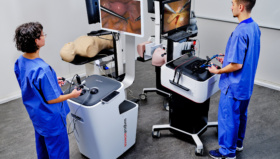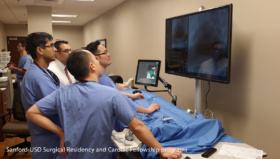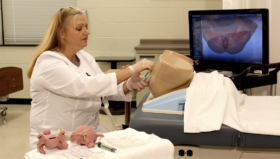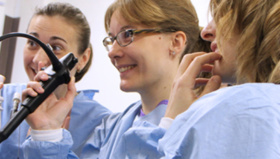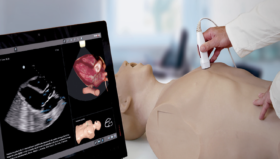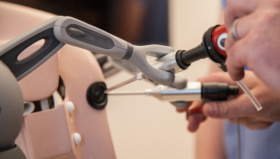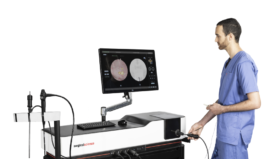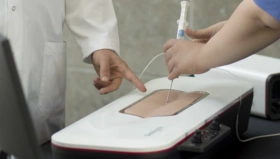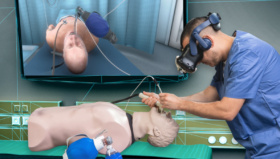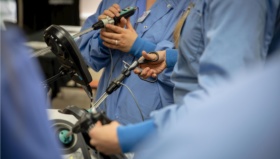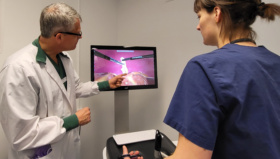Has the growth of robotic surgery been at the expense of open surgery or laparoscopy?
One of the commonly held beliefs is that robotic surgery has helped increase the overall growth of less invasive surgery and particularly moved patients from having an open approach to a less invasive approach.
This was definitely the case with Prostatectomy in the US when period to the launch of the da Vinci® in the early 2000’s, a study by Mark Tyson1 on Prostatectomy trends in the US showed that less invasive approach to RP (Radical Prostatectomy) went from less than 1% in 1998 to close to 67% in 2011. This was a clear conversion from the open approach to the robotic approach as there had been little penetration of a minimally invasive approach in the US market.
I have been doing some analysis on the adoption RARP (Robotic Assisted Radical Prostatectomy) in the UK and have developed a mixed chart using two data sources. The first being data from a report published by The British Association of Urological Surgeons Limited (BAUS) in 2012 on the development of RARP in the UK2. This provided data for 2009 and 2010. The data from 2014 onwards is based on my own research from the BAUS registry. The dotted lines are a hypothesis on what might have happened between the two published data sets.
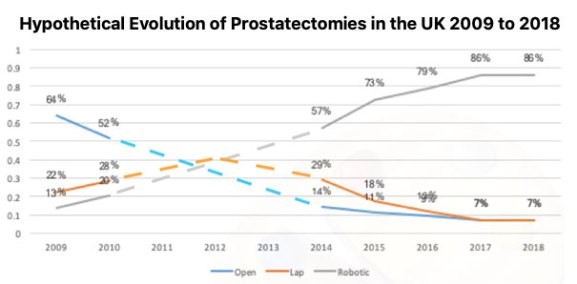
It is clear that with the introduction of the da Vinci®, there was an increase in the less invasive approach to RP at the expense of open. It is interesting that the laparoscopic approach also increased initially as there was a move away from open to a less invasive approach.
A more recent paper in the Jama Open network has also tracked the adoption rates of robotic surgery this time in general surgery in Michigan. It is interesting to see that during the first five years of the study period the rate of laparoscopic procedure and robotic procedures both increase while the open approached decreased. In the last two years, it would appear that there has been a greater move from laparoscopic to robotic than open to less-invasive.
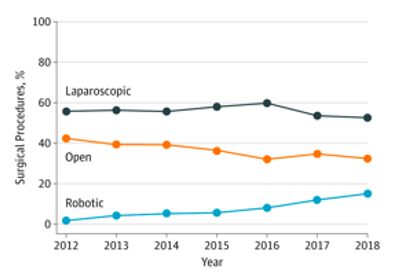
Temporal Trends in the Proportional Use of Robotic, Laparoscopic, and Open Surgery. Data are from the Michigan Surgical Quality Collaborative from January 1, 2012, through June 30, 2018. These data reflect practices at all hospitals included in the study.
Temporal Trends in the Proportional Use of Robotic, Laparoscopic, and Open Surgery.
Data are from the Michigan Surgical Quality Collaborative from January 1, 2012, through June 30, 2018. These data reflect practices at all hospitals included in the study.
One of the drivers of this could perhaps be explained by another graph from the same study. This shows the change in approach before and after the introduction of a robotic system. Interestingly, the less invasive approach is seen to increase before the arrival of the robot. Would this have happened anyway it is hard to say. As soon as the robot arrives it would appear that there is a greater transfer from the laparoscopic approach to the robotic approach than from open to less invasive.
Changes in Procedure Approach After Hospitals
Began Performing Robotic Surgery.
Proportional use of robotic, laparoscopic, and open approaches for general surgical procedures are shown in the 4 years before and after hospitals began performing robotic general surgery.
From 2012 to 2018, 23 of 73 hospitals (31.5%) in the Michigan Surgical Quality Collaborative started performing robotic general surgery. These data are restricted to those hospitals.
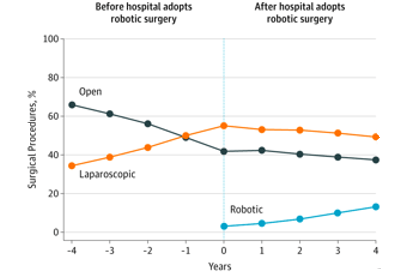
Began Performing Robotic Surgery.
Proportional use of robotic, laparoscopic, and open approaches for general surgical procedures are shown in the 4 years before and after hospitals began performing robotic general surgery.
From 2012 to 2018, 23 of 73 hospitals (31.5%) in the Michigan Surgical Quality Collaborative started performing robotic general surgery. These data are restricted to those hospitals.
In conclusion, one can say that there is no doubt that the advent of robotic surgery has led to an increase in less invasive surgery. With prostatectomy, the case is clear that this growth was as at the expense of open surgery. The robotic approach appears to be replacing the laparoscopic approach as well. In other specialties, the picture is far less clear cut. In general surgery and gynecology, the laparoscopic approaches have been around for much longer periods of time. In benign surgeries, both robotic and laparoscopic are increasing at the expense of open procedures. In oncologic procedures, robotic surgery utilization is increasing more than laparoscopic and both are increasing while open surgeries decrease. The implication for training is that surgeons have clearly had to master a number of approaches. It will be very interesting to see what the advent of new robotic platforms has on the growth of the less invasive approach and also the training implications as surgical teams will need to be trained across different platforms. With training hours now being limited in most programs, more efficient utilization of smart simulation will be required in the future to ensure that all surgeons are proficient in all approaches to surgery.
Author: Christopher Simmonds, BS, PGCE
References
1) Radical Prostatectomy Trends in the United States: 1998 to 2011. Mark D. Tyson II, MDa, Paul E. Andrews, MDa, Robert F. Ferrigni, MDa, Mitchell R. Humphreys, MDa, Alexander S. Parker, PhDb, Erik P. Castle, MDa
2) Advice on the Development of Robotic Assisted Radical Prostatectomy in England. Prostate cancer advisory group 2011 BAUS .org.uk
3) Trends in the Adoption of Robotic Surgery for Common Surgical Procedures
